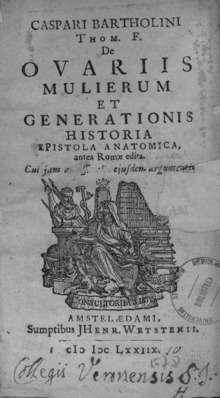Caspar Bartholin the Younger
Caspar Bartholin the Younger (/bɑːrˈtoʊlɪn, ˈbɑːrtəlɪn/;[1] Latinized: Caspar Bartholin Secundus; 10 September 1655 – 11 June 1738), was a Danish anatomist who first described the "Bartholin's gland" in the 17th century. The discovery of the Bartholin's gland is sometimes mistakenly credited to his grandfather.[2]

Early life and education
Bartholin was born in Copenhagen, Denmark. He came from an eminent family. He is the grandson of theologian and anatomist Caspar Bartholin the Elder (1585–1629) and son of physician, mathematician, and theologian Thomas Bartholin (1616–1680). His uncle was scientist and physician Rasmus Bartholin (1625–1698).
Academic career
Bartholin started his medical studies in 1671 at the age of 16. From 1674, he studied in the Netherlands, France and Italy. When he returned to Denmark, he was appointed as professor of philosophy at the University of Copenhagen holding lectures in anatomy and physics. He described the glands that bear his name in 1677. In about 1696, Danish-born French anatomist Jacob B. Winslow (1669 –1760) was Bartholin's prosector.

Hagestedgård
Bartholin inherited the Hagestedgård manor house and estate at Holbæk from his father in 1680. He sold the estate to Laurits Jacobsen in 1575 but reacquired it in 1695. He then sold it, for a second time, to Ursula von Putbus in 1704.[3] [4]
Works
- De tibiis veterum et earum antiquo usu, p. PP7, at Google Books. Rome: B. Carrara, 1677 (Bartholin also wrote about music)
- De ovariis mulierum et generationis historia epistola anatomica, p. PA1, at Google Books. Amsterdam: J. H. Wetstein, 1678
References
- "Bartholin's gland". Random House Webster's Unabridged Dictionary.
- "Kasper Bartholin d. y., den föregåendes broder, f. 1655, d. 1738,". Nordisk familjebok. Retrieved January 1, 2019.
- "Hagestedgaard: Ejerhistorie". danskeherregaarde.dk. Retrieved 25 August 2018.
- "Sag: Hagestedgård". kulturarv.dk. Retrieved January 1, 2019.
| Wikimedia Commons has media related to Caspar Bartholin the Younger. |